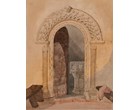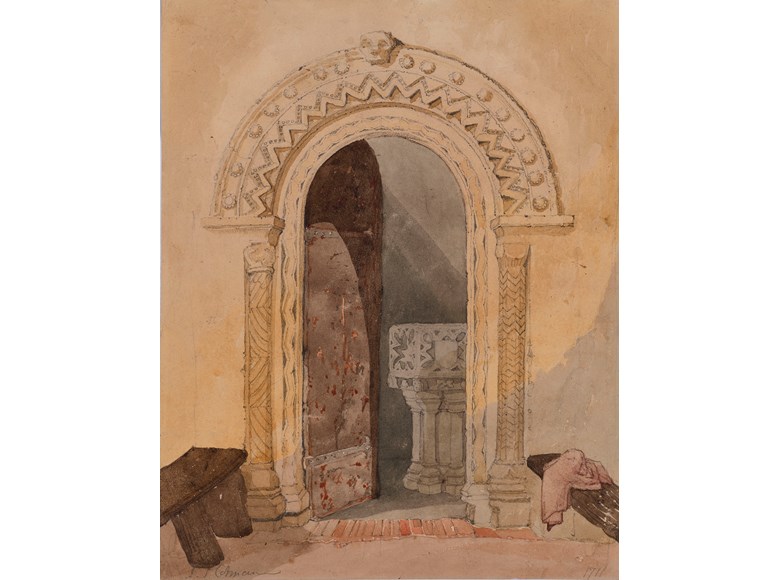 BACK TO GALLERY
BACK TO GALLERY
Lowell Libson & Jonny Yarker Ltd
John Sell Cotman
The South Door, All Saints, Kirby Cane, Norfolk
Signed lower left: ‘J.S Cotman’
Numbered lower right: 1711
9 ½ x 7 ½ inches; 239 x 190 mm
description
This spare, highly evocative watercolour was made by John Sell Cotman at the beginning of his career, shortly after he returned to his native Norwich from a period in London. Regarded as one of the most fertile and creative moments in Cotman’s career, his early Norwich watercolours show a technical innovation and clarity of vision that has long seen him regarded as one of the pioneers of the medium and the true successor to Girtin and his Romanic vision. In the present sheet, Cotman has focused on the south door at All Saints, Kirby Cane, building the composition with controlled, planar washes to create a composition of quiet monumentality. It was these flat areas of wash which caused Cotman to be co-opted in the twentieth century as a proto-modernist, as the writer and critic Laurence Binyon noted in his survey English Water-Colours, published in 1933: ‘there was no need to invoke Cézanne, for Cotman was there to show the way.’
In 1806 Cotman had failed to be elected a member of the newly founded Society of Painters in Water Colours (later known as the Old Watercolour Society) and it was this failure which almost certainly precipitated his return to Norwich. He exhibited for the last time at the Royal Academy and set up a school of drawing in Wymer Street, Norwich. Possibly in a concerted effort to establish himself with the Norwich public, he began to devote himself to the depiction of Norwich architecture. In the 1807 exhibition of the Norwich Society of Artists, founded in 1805 by John Crome and others, Cotman showed twenty works, including three of the city itself. In 1808, his tally rose to 67, but, though he was at pains to demonstrate the full range of his abilities, there were no watercolours of Norwich.
Kirby Cane is about 14 miles from Norwich, the South door of All Saints church is Norman with an unusually carved and decorated arch. Cotman shows the door partly open to reveal the fourteenth-century font beyond. As with other watercolours of Norfolk churches, Cotman delights in recording the play of light and shade on worn stone, brick and wood; handled with a series of carefully applied watercolour washes. This watercolour was engraved for Specimens of Architectural Remains in Various Counties in England, but principally in Norfolk which Cotman published in collaboration with the antiquarians Dawson Turner and Thomas Rickman in two volumes in 1838. Andrew Hemingway has suggested that Cotman’s choice of views suggest a considerable interest in pre-gothic architecture, 'which was felt to express the sobriety and virility of Norman culture.'
The watercolour is in exceptional condition and has an unbroken provenance, having originally belonged to the Revd. James Bulwer, Cotman’s pupil. The Bulwer collection was described as ‘nearly as rich as that of Dawson Turner in antiquarian material’ and ‘immeasurably more so in artistic quality.'
In 1806 Cotman had failed to be elected a member of the newly founded Society of Painters in Water Colours (later known as the Old Watercolour Society) and it was this failure which almost certainly precipitated his return to Norwich. He exhibited for the last time at the Royal Academy and set up a school of drawing in Wymer Street, Norwich. Possibly in a concerted effort to establish himself with the Norwich public, he began to devote himself to the depiction of Norwich architecture. In the 1807 exhibition of the Norwich Society of Artists, founded in 1805 by John Crome and others, Cotman showed twenty works, including three of the city itself. In 1808, his tally rose to 67, but, though he was at pains to demonstrate the full range of his abilities, there were no watercolours of Norwich.
Kirby Cane is about 14 miles from Norwich, the South door of All Saints church is Norman with an unusually carved and decorated arch. Cotman shows the door partly open to reveal the fourteenth-century font beyond. As with other watercolours of Norfolk churches, Cotman delights in recording the play of light and shade on worn stone, brick and wood; handled with a series of carefully applied watercolour washes. This watercolour was engraved for Specimens of Architectural Remains in Various Counties in England, but principally in Norfolk which Cotman published in collaboration with the antiquarians Dawson Turner and Thomas Rickman in two volumes in 1838. Andrew Hemingway has suggested that Cotman’s choice of views suggest a considerable interest in pre-gothic architecture, 'which was felt to express the sobriety and virility of Norman culture.'
The watercolour is in exceptional condition and has an unbroken provenance, having originally belonged to the Revd. James Bulwer, Cotman’s pupil. The Bulwer collection was described as ‘nearly as rich as that of Dawson Turner in antiquarian material’ and ‘immeasurably more so in artistic quality.'






 SEND AN EMAIL
SEND AN EMAIL